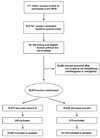Vitamin E and age-related macular degeneration in a randomized trial of women
- PMID: 20153900
- PMCID: PMC2881167
- DOI: 10.1016/j.ophtha.2009.10.043
Vitamin E and age-related macular degeneration in a randomized trial of women
Abstract
Objective: To test whether alternate day vitamin E affects the incidence of age-related macular degeneration (AMD) in a large-scale randomized trial of women.
Design: Randomized, double-masked, placebo-controlled trial.
Participants: Thirty-nine thousand eight hundred seventy-six apparently healthy female health professionals aged 45 years or older.
Intervention: Participants were assigned randomly to receive either 600 IU of natural-source vitamin E on alternate days or placebo.
Main outcome measures: Incident AMD responsible for a reduction in best-corrected visual acuity to 20/30 or worse based on self-report confirmed by medical record review.
Results: After 10 years of treatment and follow-up, there were 117 cases of AMD in the vitamin E group and 128 cases in the placebo group (relative risk, 0.93; 95% confidence interval, 0.72-1.19).
Conclusions: In a large-scale randomized trial of female health professionals, long-term alternate-day use of 600 IU of natural-source vitamin E had no large beneficial or harmful effect on risk of AMD.
Copyright 2010 American Academy of Ophthalmology. Published by Elsevier Inc. All rights reserved.
Figures


Similar articles
-
Low-dose aspirin and medical record-confirmed age-related macular degeneration in a randomized trial of women.Ophthalmology. 2009 Dec;116(12):2386-92. doi: 10.1016/j.ophtha.2009.05.031. Epub 2009 Oct 7. Ophthalmology. 2009. PMID: 19815293 Free PMC article. Clinical Trial.
-
Vitamins E and C and medical record-confirmed age-related macular degeneration in a randomized trial of male physicians.Ophthalmology. 2012 Aug;119(8):1642-9. doi: 10.1016/j.ophtha.2012.01.053. Epub 2012 Apr 13. Ophthalmology. 2012. PMID: 22503302 Free PMC article. Clinical Trial.
-
Vitamin E and age-related cataract in a randomized trial of women.Ophthalmology. 2008 May;115(5):822-829.e1. doi: 10.1016/j.ophtha.2007.06.040. Epub 2007 Dec 11. Ophthalmology. 2008. PMID: 18067963 Clinical Trial.
-
Design of Physicians' Health Study II--a randomized trial of beta-carotene, vitamins E and C, and multivitamins, in prevention of cancer, cardiovascular disease, and eye disease, and review of results of completed trials.Ann Epidemiol. 2000 Feb;10(2):125-34. doi: 10.1016/s1047-2797(99)00042-3. Ann Epidemiol. 2000. PMID: 10691066 Review.
-
Folic acid supplementation and malaria susceptibility and severity among people taking antifolate antimalarial drugs in endemic areas.Cochrane Database Syst Rev. 2022 Feb 1;2(2022):CD014217. doi: 10.1002/14651858.CD014217. Cochrane Database Syst Rev. 2022. PMID: 36321557 Free PMC article.
Cited by
-
Effect of Vitamin D and ω-3 Fatty Acid Supplementation on Risk of Age-Related Macular Degeneration: An Ancillary Study of the VITAL Randomized Clinical Trial.JAMA Ophthalmol. 2020 Dec 1;138(12):1280-1289. doi: 10.1001/jamaophthalmol.2020.4409. JAMA Ophthalmol. 2020. PMID: 33119047 Free PMC article. Clinical Trial.
-
Nutritional modulation of age-related macular degeneration.Mol Aspects Med. 2012 Aug;33(4):318-75. doi: 10.1016/j.mam.2012.03.005. Epub 2012 Apr 6. Mol Aspects Med. 2012. PMID: 22503690 Free PMC article. Review.
-
Dietary supplements and disease prevention - a global overview.Nat Rev Endocrinol. 2016 Jul;12(7):407-20. doi: 10.1038/nrendo.2016.54. Epub 2016 May 6. Nat Rev Endocrinol. 2016. PMID: 27150288 Review.
-
Vitamin E and Multiple Health Outcomes: An Umbrella Review of Meta-Analyses.Nutrients. 2023 Jul 25;15(15):3301. doi: 10.3390/nu15153301. Nutrients. 2023. PMID: 37571239 Free PMC article.
-
Retinoid Synthesis Regulation by Retinal Cells in Health and Disease.Cells. 2024 May 18;13(10):871. doi: 10.3390/cells13100871. Cells. 2024. PMID: 38786093 Free PMC article.
References
-
- Eye Diseases Prevalence Research Group. Prevalence of age-related macular degeneration in the United States. Arch Ophthalmol. 2004;122:564–572. - PubMed
-
- Klein R, Wang Q, Klein BE, et al. The relationship of age-related maculopathy, cataract, and glaucoma to visual acuity. Invest Ophthalmol Vis Sci. 1995;36:182–191. - PubMed
-
- Hogg RE, Chakravarthy U. Visual function and dysfunction in early and late age-related maculopathy. Prog Retin Eye Res. 2006;25:249–276. - PubMed
-
- Klein R, Klein BE, Tomany SC, et al. Ten-year incidence and progression of age-related maculopathy: The Beaver Dam Eye Study. Ophthalmology. 2002;109:1767–1779. - PubMed
Publication types
MeSH terms
Substances
Grants and funding
LinkOut - more resources
Full Text Sources
Medical

